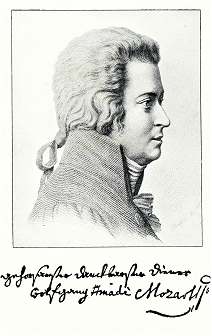 Who really commissioned Mozart’s Requiem, and who actually wrote it?
Who really commissioned Mozart’s Requiem, and who actually wrote it?
So who hired Mozart to write the piece? The answer boils down to a rather pathetic story, concerning a rather pathetic figure: Count Franz von Walsegg, a fantastically wealthy nobleman who lived south of Vienna. He wasn’t content with his numerous estates, his gypsum mines, his castles. No. He wanted to be a composer, and there was only one obstacle standing in his way: he had no compositional talent. So he would commission pieces from people who did and pass them off as his own, presenting the music at his twice-weekly concerts. His friends and employees were apparently well aware of the deception but played along. What was the harm? The Count was happy and the well-paid-but-anonymous composers were happy. And the invitees to the private performances got to hear wonderful music, so they were happy too. It’s very unfortunate that the whole endeavor was based on a lie. The Count could have given credit where credit was due, become known as a patron of the arts by his encouragement of new music, still given his concerts and participated with his playing of the flute and cello, and everyone would still have been happy. There would have been no snickering behind the Count’s back, either.
When Walsegg’s young wife died in 1791, he resolved to honor her memory by building her a great memorial and by commissioning a requiem mass that he would claim as his own. He must have been aware of Mozart’s prodigious talent and so chose him to do the work. Mozart was not to know who was paying for the piece, and Walsegg’s lawyer probably sent his clerk to make the deal. Since Mozart didn’t know the man he described him as the “gray messenger,” apparently because . . . get ready for it! . . . the guy was dressed in gray clothes. That simple little description was the start of the endless speculation about the commission, as the phrase sounds ominous if you don’t know the actual situation. Mozart was overloaded with other projects and deadlines and was reluctant to accept this new work, so he decided to ask for an extremely high price: 60 ducats. (How much was that worth? Very hard to say. Mozart’s salary as a court composer had been 200 ducats a year, so he was asking almost a third of that amount for just one piece.) To his surprise, the messenger agreed and returned with 30 ducats, promising the remainder upon delivery of the completed work.
After Mozart finally put the score of The Magic Flute into the hands of his long-suffering friend and impresario Emanuel Schikaneder at the end of September 1791 he was able to turn at least some of his attention to the requiem. But his health was rapidly failing, and during November he fell into his final illness, trying to work on the requiem even on his deathbed. (Unfortunately, the scene in the movie Amadeus where Antonio Salieri takes dictation from the dying Mozart didn’t happen.) Finally, though, Mozart recognized that he would not be able to finish it and reportedly summoned his student/assistant, Franz Xaver Süssmayr, for instructions on finishing the work. He died on December 5.
If I tried to explain all of the complications that then ensued in the story of the requiem’s completion, I would probably exhaust the patience of even the most ardent fan of this piece. If you do want to get the full story of the incredible twists and turns that finally led to the masterpiece we have today, I would encourage you to read the post at a website dedicated to the life and music of Salieri, ironically enough. You’ll find yourself completely confused at several points in the story, which is completely normal, as our sources are pretty confused, too. After a couple of other musicians had a go, Süssmayr was finally allowed to finish it. Not everyone is happy with his version. There have been performances in which only the sections known to be written by Mozart are included. The most drastic step taken by some musicologists and composers has been to scrap Süssmayr’s work and start over. Neither one of these approaches seems reasonable. The person with the closest musical association to Mozart and who (probably) was given guidance by him as to the completion of the work seems to be the best bet, and that’s the version we will perform.
Perhaps that’s enough for now. Next week I’ll start looking at the actual text and music. Whatever the story about how the music got written down, what really matters is the music itself. So we’ll concentrate on that from now on.

